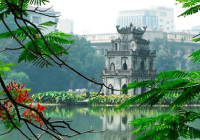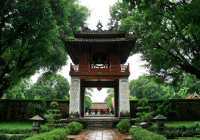* Don Mueang Int'l Airport
Hanoi, the capital of Vietnam, is known for its centuries-old architecture and a rich culture with Southeast Asian, Chinese and French influences. At its heart is the chaotic Old Quarter, where the narrow streets are roughly arranged by trade. There are many little temples, including Bach Ma, honoring a legendary horse, plus Dong Xuan market, selling household goods and street food.

The One Pillar Pagoda was originally built by the Emperor Ly Thai Tong who ruled from 1028 to 1054. According to the annals, the heirless emperor dreamed that he met Quan The Am Bo Tat, the Goddess of Mercy, who handed him a male child. Ly Thai Tong then married a young peasant girl and had a son and heir by her. As a way of expressing his gratitude for this event, he constructed a pagoda here in 1049.
Legend claims in the mid-15th century Heaven sent Emperor Ly Thai To a magical sword, which he used to drive the Chinese from Vietnam. After the war a giant golden turtle grabbed the sword and disappeared into the depths of this lake to restore the sword to its divine owners, inspiring the name Ho Hoan Kiem. Every morning at around 6am local residents practise traditional t’ai chi on the shore. The ramshackle Thap Rua , on an islet near the southern end, is topped with a red star and is often used as an emblem of Hanoi.

Founded in 1070 by Emperor Ly Thanh Tong, the Temple of Literature is dedicated to Confucius (Khong Tu). Inside you'll find a pond known as the 'Well of Heavenly Clarity', a low-slung pagoda and statues of Confucius and his disciples. A rare example of well-preserved traditional Vietnamese architecture, the complex honours Vietnam’s finest scholars and men of literary accomplishment.

One of the oldest pagodas in Vietnam, Tran Quoc Pagoda is on the eastern shore of Ho Tay, just off Ð Thanh Nien, which divides this lake from Truc Bach Lake. A stela here, dating from 1639, tells the history of this site. The pagoda was rebuilt in the 15th century and again in 1842.
